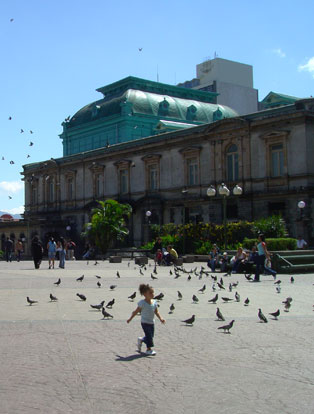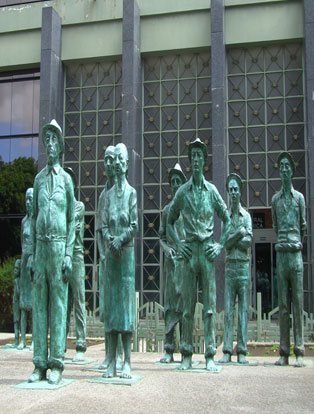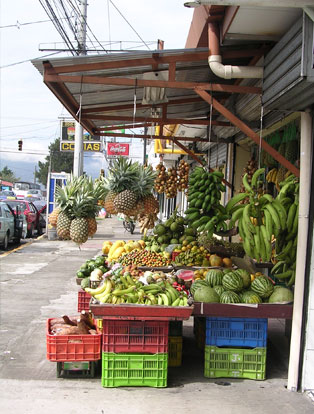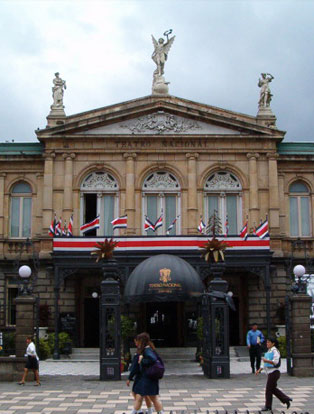
During your stay in Costa Rica you will meet quite a few people. Let’s introduce some of the people you will meet at ILISA.
The program director
Hellen Rojas is ILISA’s Program Director and is responsible for organizing all classes, including placing students according to their Spanish level. If you have any questions and/or comments regarding your classes or teachers, please don’t hesitate to talk with her at anytime.
The teachers
Our teachers here at ILISA are all well-trained, experienced and enthusiastic individuals. On one of the bulletin boards at ILISA ‘s entrance you will find the names and pictures of all of our teachers. They have all been working with ILISA for quite some time, and we know that you will enjoy your classes with them.
Like most large cities, San Jose has its share of petty theft. In most cases it is non-confrontational; sometimes you don’t even realize what happened until after the fact.
If you use common sense and take the normal precautions required in any major city, there is no reason to worry. A few tips:
- Don’t wear a lot of jewelry or carry around valuables. Leave them in your family’s home.
- If you carry a daypack, put your valuables in the largest pocket because this tends to be a safer place to keep things from pickpockets.
- Hold on firmly to your purse.
- If you set your bag down, try to maintain physical contact with it (i.e. put your foot on the strap).
- Keep money in front rather than back pockets,
- Do not flash around large amounts of money.
- Be aware; try to look in control.
- If you have a rental car, take the same precautions you would at home. Park in parking lots and always lock the car.
There is a phone at ILISA’s reception desk that is available for student use.
Public telephones are of three types. The older, coin operated phones will accept silver 5, 10 and 20 colon coins. Set the coin in the slot on top of the phone, then dial; the coin will drop down when a connection has been made. Extra coins set in the slot will be used only as needed. Ignore the loud beeps at the beginning of the call; that’s just the way some public phones work.
The second type of phone, “chip” phones, accept phone cards with computer chips in them. Stick the phone card in the slot on the front of the phone and the amount of available funds will appear on the screen.
Colibrí phones are for use with locally-purchased pre-paid phone cards. You will have to dial in the card number which is on the back of the card. Colibrí cards are available in small denominations for local calls and in larger denominations for international calling; the cards can be used from any phone. ILISA sells colibri cards.
For North Americans, the easiest alternative for international calling is bringing a calling card from home. While the big three (AT&T, MCI, Sprint) and several European phone companies have local access numbers, most smaller companies do not. And, in Costa Rica, 1-800 calls are charged as international calls. You will also not be able to use your calling card to call third countries. (For example, you can’t call Peru from Costa Rica with your AT&T card.)
The other easy alternative is calling collect (dial 175 to get an operator). Make arrangements to pay people back when you return. Person-to-person calls which you pay in ILISA are expensive and quite a hassle.
AT&T local access number: 0-8000-114-114
MCI local access number: 0-8000-122-222
Sprint local access number: 0-8000-130-123
Collect to Denmark 0-8000-451-045
Collect to Germany: 0-8000-491-049
Collect/Calling Card to Canada: 0-8000-151-161
AT&T Canada: 0-800-152-000
Preparing for an Immersion Program
Studying at a language school abroad is one of the best ways to improve your language skills. To get the best results, you should prepare yourself before you leave. For example, exercises that improve your vocabulary are well worth the time and effort. If you are a beginner, this will help you feel more comfortable once your total immersion program begins.
Here are a few good ideas:
- Find someone who is a native speaker of the language you want to learn. Ask this person to make a tape-recording of a chosen text, and listen to it over and over until you know it well enough to recite it along with the speaker. This will help you to become accustomed to recognizing certain words that you already know in writing.
- Read your text and/or listen to your tape right before you go to sleep. This allows you to subconsciously work on the new material while you are sleeping.
- Enroll in a beginner’s course at a local language school or education center. This will give you a good introduction to the language before you go abroad to study. It also allows you the opportunity to decide if you really like your chosen language.
If you are an absolute beginner, we recommend that you buy a small phrase book, preferably one with an accompanying tape, and try to learn 20 or 30 useful phrases that you will need all the time. Most phrase books contain an introductory section where you can find the little phrases and expressions that make communication easier: “please, thank you, excuse me, I’m sorry, can you help? I’d like some…, have you got a …? how much is…? yes, no”, and so on.
Master a short list of phrases like this, and you will be surprised how many simple situations you can deal with. Expressions of this sort will not solve all your communication problems, but they will facilitate basic conversation.
If you are a more advanced learner, you need more complex advice because you aren’t learning the language from scratch – it’s more often a case of a building on a weak foundation that you have already attained. Our advice in this case is to learn as many common words as you can before you leave for your study trip. When you learn a foreign language in your own country you lack a great deal of “everyday” vocabulary. This can cause a real shock when you go abroad and attempt to talk to native speakers.
You can’t really be functional in a foreign language until you know 2,000 – 3,000 words well. That’s roughly the same number of words that a four or five-year-old child knows – enough to cope with most everyday situations.
For most purposes, there are lots of ways you can build up your vocabulary before you leave for a trip. Most good book stores stock children’s picture books with basic vocabularies in the major Western Languages. You can use these to learn simple words that you are likely to need. If you already have a rough idea of the grammar of the language you are learning, then another good idea is to buy a newspaper in the language you are planning to learn, and work through the headlines, using a dictionary.
You should cut out, or copy down any headline that contains a word you don’t know. Keep them in a little notebook, and review them three or four times a day. This will give you a basic vocabulary referring to things that are currently in the news – just the sort of things that people are likely to want to talk to you about. You can make some of this vocabulary active if you systematically practice productive tasks using the words you’ve just learned.
Buy a small pack of picture postcards, and each day spend a few minutes with each card identifying the things you can see in them (in the foreign language of course). At first, you might find that you can only list a few objects, but with practice, you will be able to string together a couple of simple phrases.
For some of you, a study trip abroad isn’t so much about learning a new language, or about building on a foundation. It’s simply a case of brushing up on a language you once knew quite well, but have since forgotten. In cases like these, you can often reactivate much of what you knew in a short period of intensive reading. When you stop using a language, the words you have learned don’t disappear from you mind, they just lurk in your subconscious. Reading will reactivate many of the things you once knew. So, a few hours of serious reading will allow you to remember words that you thought were forgotten.
It helps even more if you have a book that you know fairly well and perhaps enjoy reading. Cartoon strips, or children’s books seem to be particularly useful for this, as they usually have good illustrations and simple story lines. Cartoon strips in particular are usually written in dialogue that you can use for many situations in which you may find yourself. Also, any text of reasonable length, say 20 or 30 pages, will contain a large vocabulary. Most of the vocabulary will be frequently used words that you will need to know yourself, and be able to use automatically while abroad.
Many language courses abroad concentrate more on conversation skills and grammar than on vocabulary. That’s fine if you start with a sizable vocabulary, but if you don’t, you may find yourself often stuck for a simple word in the middle of a public situation, which can be embarrassing.
Once you have a good basic vocabulary, most of what happens your language class becomes simple: grammar exercises are just a matter of slotting familiar words into new environments, and conversation is just a matter of effectively using words you already know.
Like anything else, a good start is half the job. Please help yourself by being well prepared before you start an immersion program.
“Acclaimed as the most magnificent bird in the Western Hemisphere, the resplendent Quetzal owes his elegance to the intensity and brilliant contrasts of his colors. The rich crimson of his underparts contrast with the iridescent green of the head, chest and upperparts. His head is crowned with a narrow crest of upstanding feathers that extend from the small yellow bill to the nape. His pointed tips of the long loose-barbed coverts of the wings project over the crimson of his sides in beautiful contrast.
Most notable are his central tail coverts, which stretch far beyond the tail and like two slender green pendants, undulate gracefully when the quetzal flies. When viewed from below, the pure white outer tail feathers contrast with the crimson of his belly.
As may be seen on many an ancient sculpture and modern painting, the long tail coverts were highly valued as personal adornments by the Aztec and Mayan nobility. As Guatemala’s national bird, the peaceful quetzal contrast refreshingly with the fierce predators and firebreathing monsters that other nations have chosen for their emblems. Years ago, Guatemalans assured me that their symbol of liberty would die if deprived of freedom, but modern aviculturists have learned how to keep it alive – a hard negation of a beautiful myth.” -Renowned ornithologist Alexander Skutch
Baha’i – The information center is in La Uruca (south side of the Catholic church; open Monday through Friday, 8 a.m. to 4 p.m.; 231-0467).
Baptist – The International Baptist Church of Costa Rica is located at Faro del Caribe, San Francisco de Dos Ríos. (237-7569; ersteel@racsa.co.cr)
Catholic – Saint Mary’s Chapel, adjacent to the Sheraton Herradura Hotel in San Jose, has an English mass Sunday at 4 p.m. The San Rafael de Escazú Church holds an English mass Saturday at 5 p.m.
Episcopal – English services are Sunday at 8:30 a.m. at the Church of the Good Shepherd (Avenida 4, Calles 3/5; 222-1560).
Jewish – Reform: Bilingual services are held Friday at 8 p.m. at Congregation B’nei Israel (232-9626). Conservative: Synagogue Shaare Zion (Calle 22 bis, Avenida 1; 233-9222) has services Friday at 5:30 p.m.
Methodist – Sunday services are at 10a.m.(Avenida Central, Calles 9/11 (222-0360).
Mormon – Sacrament meetings are on Sunday at 9 a.m.; the temple is in Barrio Los Yoses (Avenida 8, Calles 33/35; 225-0208, 234-1940).
Many of Costa Rica’s beaches have riptides, strong currents that can drag swimmers out to sea. A riptide occurs when water that has been dumped on the shore by strong waves forms a channel back out to open water. These channels have strong currents. If you get caught in a riptide, you can’t escape the current by swimming toward shore–the equivalent of swimming upstream in a river. To break free of the current, swim parallel to shore, and use the energy of the waves to help you get back to the beach.
Buy coffee. If you’re a coffee drinker or if you know some coffee drinkers (we guess that includes everyone), then be sure to stock up on fresh-roasted coffee beans before you head home. Café Britt is the coffee you’ll see sold in hotels and souvenir shops all over the country. Sure, it’s good coffee, but it’s also overpriced. If you go into the central market in downtown San José or in grocery stores anywhere in the country, you’ll find coffee at much lower prices. Just be sure you’re buying whole beans. Costa Rican grinds are much finer than U.S. grinds and often have sugar mixed right in to the coffee. Costa Rica also produces its own coffee liqueur (Café Rica), including a crème liqueur (Salicsa), both of which are quite inexpensive. These are best purchased in a liquor store or a grocery store. Salsa Lizano, a flavorful green sauce is another item worth bringing home with you.
Costa Rica is not known for its handcrafts, though it does have a town – Sarchí is best known as the home of the colorfully painted Costa Rican oxcart, reproductions of which are manufactured in various scaled-down sizes. There is also a lot of furniture made in Sarchí. You can also buy crafts closer to school in Moravia (a neighborhood north of San Pedro), in the International Crafts Market in Curridabat (east of San Pedro) or in the Central Market downtown.
A few other items worth keeping an eye out for include reproductions of pre-Columbian gold jewelry and carved stone figurines. The former are available either in solid gold, silver, or gold plated. The latter, though interesting, are extremely heavy.
If you just have to watch that NFL Monday night football game, or your weekly hit of boxing, basketball, baseball or soccer you can certainly find central watering holes where you can belly up to a television set. In San Pedro, try sports bar All Star in front of Mall San Pedro. In San José, there is a veritable plethora. Try Tiny’s Tropical Bar (Calle 9/11, Ave.2), Nashville South (Calle 5, Ave. 1/3) or the Holiday Inn bar (Calle 5/7, Ave.10, second floor), all centrally located.
Costa Rica is a huge soccer playing nation and its cheap and easy to go see a good quality live professional game. Check out La Nacion for details.
![]()
Orientation A-Z: Index-A B-C D-F G-J L-O P-S T-Z




